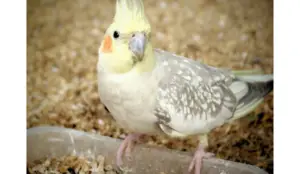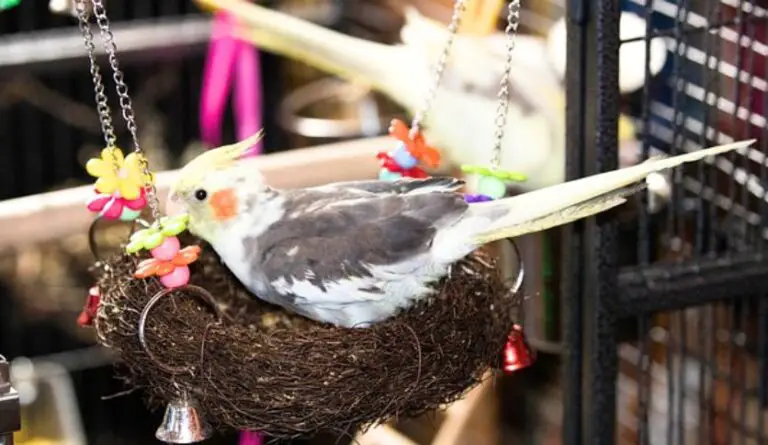Cockatiels molt once or twice a year, typically in spring and/or autumn. During this process, they shed old feathers and grow new ones.
The molting period lasts a few weeks, during which owners should provide proper care to support their bird’s health and feather regrowth. Understanding when cockatiels molt helps owners anticipate and address their pet’s changing needs.
The Basics Of Cockatiel Molting
Molting is a natural process where cockatiels shed and replace old feathers with new ones. This enables them to maintain healthy plumage and enables their feathers to perform vital functions such as flight, insulation, and displaying dominance. Molting usually occurs once or twice a year in adult cockatiels. Young cockatiels will experience their first molt at around 6-12 months of age.
What Is Molting And Why Do Cockatiels Molt?

Molting is the process by which cockatiels shed and replace their feathers. It is essential for their overall appearance and health. Cockatiels molt to refresh their feathers as the old ones become worn out and damaged over time. Molting also allows for the growth of new feathers with vibrant colors and patterns, enhancing their beauty. Moreover, it helps regulate body temperature and improves flight capabilities.
The Stages Of Cockatiel Molting
Cockatiel molting typically occurs in three stages: the pre-molt phase, the molt phase, and the post-molt phase. During the pre-molt phase, which can last for a few weeks, you may notice changes in behavior, such as increased vocalization, decreased appetite, and increased irritability. The molt phase sees the actual shedding of feathers, with new ones gradually growing in their place. Finally, the post-molt phase is when the new feathers have fully grown, and your cockatiel will regain its typical temperament and appearance.
Signs And Symptoms Of A Molting Cockatiel
It’s essential to recognize the signs of molting to ensure your cockatiel’s well-being. Some common signs include increased molting behavior, such as excessive preening, shaking, or scratching. You might also notice an increase in feather dust around their cage. Additionally, your cockatiel may experience slight personality changes, such as being more irritable or less energetic. Providing your cockatiel with a balanced diet and opportunities for adequate rest during molting can help ease the process and promote healthy feather growth.
When Do Cockatiels Molt
Cockatiels molt throughout their lives, but the timing and frequency of molting can vary depending on their age. Young cockatiels typically experience their first molt at around 6 to 9 months old. This is known as the juvenile molt, where they shed their baby feathers and grow in adult plumage. After this initial molt, adult cockatiels generally go through an annual molt each year.
Molting in cockatiels can be influenced by various factors, such as changes in daylight hours, temperature, hormonal fluctuations, and even nutritional factors. Cockatiels may also molt in response to stress, illness, or environmental changes. Providing a balanced diet and a comfortable environment is important to minimize stress and support a healthy molt.
| Season | Molting Pattern |
|---|---|
| Spring | Many cockatiels experience a heavy molt during spring, shedding old feathers and replacing them with new ones. |
| Summer | Molting activity may decrease during summer when the temperature increases, but it can still occur depending on individual factors. |
| Fall | Some cockatiels may have a secondary molt in the fall, though it’s usually less intense than the spring molt. |
| Winter | Winter molting tends to be minimal, with fewer feather changes occurring during this time. |
Managing Cockatiel Molting
Feather health is crucial for cockatiels during molting. A balanced diet is essential during this period to support new feather growth. Include nutrient-rich foods such as fresh fruits, vegetables, and high-quality pellets in their daily meals. Supplementation with vitamin and mineral supplements may also be beneficial.
A stress-free environment is important to minimize the impact of molting on cockatiels. Avoid sudden changes in their surroundings and provide a quiet space for them to molt comfortably. Fresh, clean water should always be available.
Grooming plays a vital role in supporting molting cockatiels. Regularly mist their feathers with water to help them loosen old feathers and promote new growth. Gentle feather massages can also aid in the process. Be cautious while trimming their nails and beak to prevent injury.
| Do: | Don’t: |
|---|---|
|
|
Dealing With Molting Challenges
Molting is a natural process for cockatiels, but it can present challenges for both the birds and their owners. One common issue during molting is feather plucking and self-mutilation. Cockatiels may become stressed or uncomfortable during this time, leading to excessive feather loss. It is important for owners to monitor their bird’s behavior and ensure that they provide a proper environment for self-care.
To prevent feather picking, owners should pay attention to any possible triggers, such as changes in diet or stressful situations. Providing a balanced and nutritious diet is crucial during molting to promote healthy feather growth. Ensuring a stress-free environment with plenty of mental and physical stimulation can help divert cockatiels’ attention from excessive grooming.
If feather plucking or self-mutilation becomes a serious issue, it is important to seek veterinary advice. A veterinarian can identify any underlying health problems and guide how to manage the behavior. With patience and proper care, molt-related challenges can be effectively addressed, allowing cockatiels to maintain their beautiful plumage and overall well-being.
The Dos And Don’ts Of Cockatiel Molting
During cockatiel molting, it is important to follow recommended steps to help your feathered friend through this natural process while avoiding common mistakes and promoting healthy feather regrowth afterward.
Recommended steps to help your cockatiel through molting:
- Provide a balanced diet rich in essential nutrients such as vitamins A, E, and protein.
- Ensure your cockatiel can access various toys and perches to stimulate natural preening behavior.
- Dust your cockatiel regularly with a bird-safe powder to help control mites and lice that can aggravate molting.
- Keep your bird’s environment clean and stress-free to minimize any additional challenges during molting.
- Avoid excessive handling or disturbing your cockatiel during molting, as this can cause added stress.
- Avoid sudden changes in diet or introducing new foods during this time, as it may disrupt their digestion.
- Avoid using artificial lighting for prolonged periods, as it can interfere with their natural molting cycle.
Tips for promoting healthy feather regrowth after molting:
- Ensure a well-rounded diet with fruits, vegetables, pellets, and occasional treats to support feather regrowth.
- Provide a stress-free environment with appropriate mental and physical stimulation to encourage healthy feather regrowth.
- Monitor for any signs of illness or abnormal feather growth and consult with a veterinarian if necessary.
Frequently Asked Questions For When Do Cockatiels Molt
Do Cockatiels Get Moody When Molting?
Yes, cockatiels can become moody when they are molting.
What Do You Feed A Cockatiel When Molting?
Feed your cockatiel a balanced diet that combines high-quality pellets, fresh vegetables, fruits, and seeds during molting. Provide plenty of clean water and add a calcium supplement to support feather growth.
During Which Month Do Most Birds, Molt?
Most birds molt during late summer or early fall when their breeding season ends, and they no longer need to maintain vibrant plumage for courtship displays and nesting. This molting period helps them replace old, worn-out feathers with fresh ones for better insulation and flight performance.
When Do Cockatiels Molt?
Cockatiels molt once or twice a year, typically during the spring and fall. The molt duration varies, but it usually lasts for a few weeks. During this time, you may notice your cockatiel losing and regrowing feathers.
A balanced diet and proper lighting can help support your bird’s molting process.
Conclusion
To summarize, understanding the molting process in cockatiels is crucial for their overall well-being. By knowing when they molt, you can provide appropriate care, such as supplying extra nutrients and minimizing stress. Remember to observe your cockatiel’s behavior and physical changes to identify the molt stage accurately.
A balanced diet and a comfortable environment will help your feathery friend maintain healthy feathers throughout their life. Happy molting!

Hi, I’m Regina Rios. Just another bird lover who loves to share knowledge from personal experience. I’ve grown up with pet birds since childhood as my mommy also loves birds. As I can’t pet many birds in open air in my house as my mom does; I created my first bird cage on my rooftop using wood, copper wire, and a metal shed in 2018 and start collecting pet birds. Now, I have so many pet birds such as Macaws, Parrot, Cockatiel, Parakeet, and others. Not only that, if I see natural birds are injured I keep them in my house until they get well. Now, my hobby becomes my income source as my home birds have babies and I sell them to birds lover like mine. I’ve created this blog to inspire others bird owners by sharing my personal knowledge. Good Luck!

